Academy, SD When several armed Lakotas appear on the opposite shore, Clark recognizes them and through interpreters tells them to stay away or be killed. After the hunters catch up, they move on and camp on a large sandbar in a defensive position.
Meeting the Tetons[1]Originally aired weekdays by Yellowstone Public Radio during the Bicentennial observance of 2003-2006. Narrated by Hal Hansen. Scripts by Whit Hansen and Ed Jacobson. Produced by Leni Holliman. © … Continue reading
Plum Hunting
Saw a large plumb orchd of the most deelicious plumbs, out of this orchard 2 large Buck Elks ran the hunters killed them. I Stoped the Canoes and brought in the flesh which was fat and fine. here the party Collected as many plumbs as they could eate and Several pecks of which they put by &c.
—William Clark
Armed Lakotas Appear
imedeatily after landing about 20 indians was discovered on an eminanc a little above us on the opposite Side. one of those men I took to be a freinch man from his a blanket Capoe & a handkerchief around his head. imediately after 80 or 90 Indian men all armed with fusees & Bows & arrows Came out of a wood on the opposite bank about ¼ of a mile below us. they fired of their guns as a Salute we returned the Salute with 2 rounds.
—William Clark
Clark’s Stern Message
I told those Indians that they had been deef to our councils and ill treated us as we assended this river two years past, that they had abused all the whites who had visited them since. I believed them to be bad people & Should not Suffer them to cross to the Side on which the party lay, and directed them to return with their band to their Camp, that if any of them come near our camp we Should kill them certainly.
—William Clark
Clark’s Warning
I also told them that I was informed that a part of all their bands were gorn to war against the Mandans &c, and that they would be well whiped as the Mandans & Menetarres [Hidatsas] & had a plenty of Guns Powder and ball, and we had given them a Cannon to defend themselves.
—William Clark
Hunters at Risk
we all this time were extreamly anxious for the arival of the 2 fields [Joseph Field and Reubin Field] & George Shannon whome we had left behind, and were Some what consd. as to their Safty. to our great joy those men hove in Sight at 6 P. M. Jo. Fields had killed 3 black tail or mule deer. we then Set out
—William Clark
A Defensive Position
our encampment of this evening was a very disagreable one, bleak exposed to the winds, and the Sand wet. I pitched on this Situation to prevent being disturbed by those Scioux in the Course of the night as well as to avoid the Musquetors—.
—William Clark
Weather Diary
State of the weather at Sun rise State of wind at Sunrise State of the weather at 4 P. M. Wind at 4 P. M. State of river cloudy after rain S E fair S. E. a fiew drops of rain last night I Saw the Tetons.
—William Clark[2]To assist the reader of this web page, the date column is omitted, some abbreviations have been spelled out, and the three river columns have been merged.
Notes
| ↑1 | Originally aired weekdays by Yellowstone Public Radio during the Bicentennial observance of 2003-2006. Narrated by Hal Hansen. Scripts by Whit Hansen and Ed Jacobson. Produced by Leni Holliman. © 2003 by Yellowstone Public Radio. |
|---|---|
| ↑2 | To assist the reader of this web page, the date column is omitted, some abbreviations have been spelled out, and the three river columns have been merged. |

